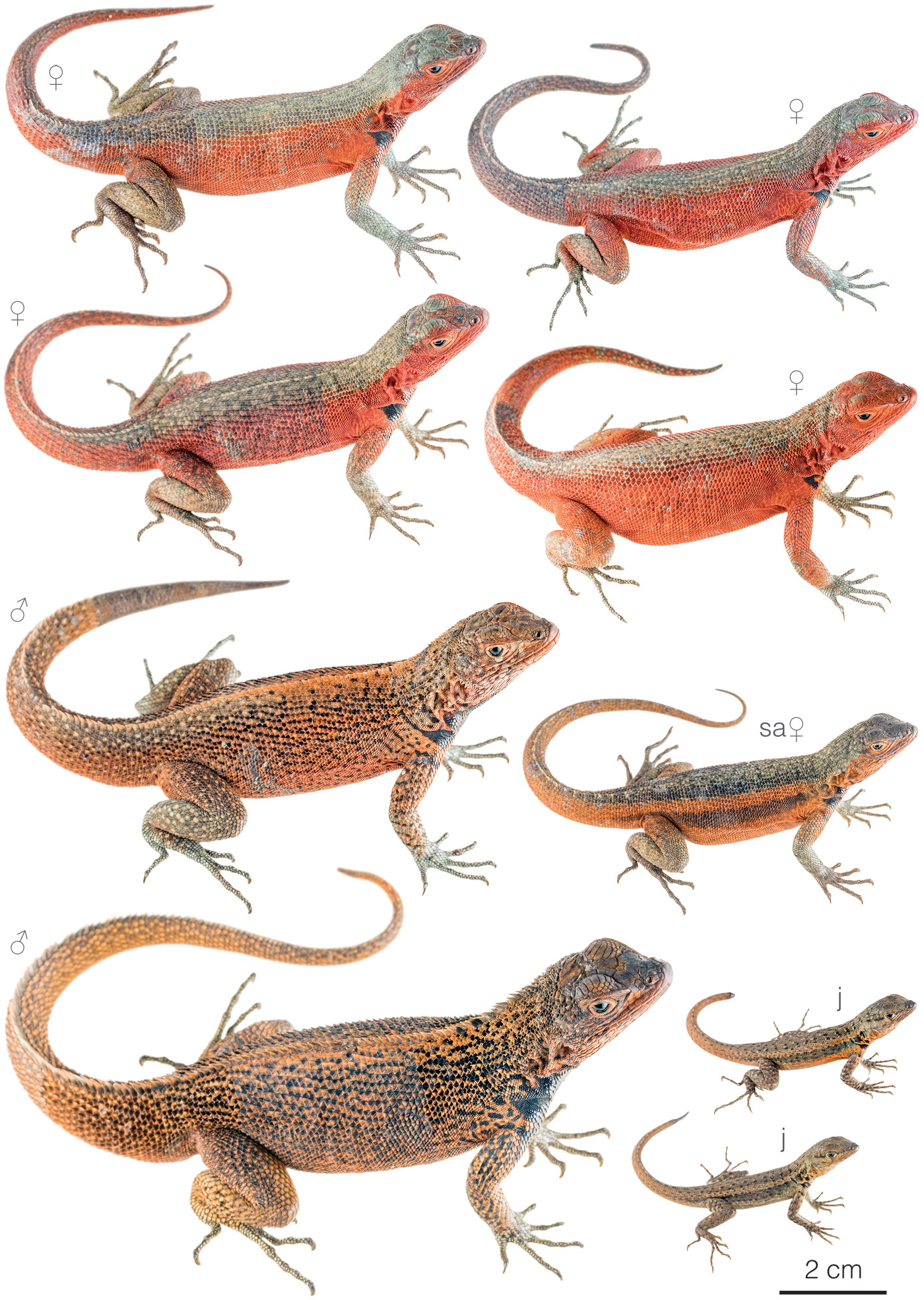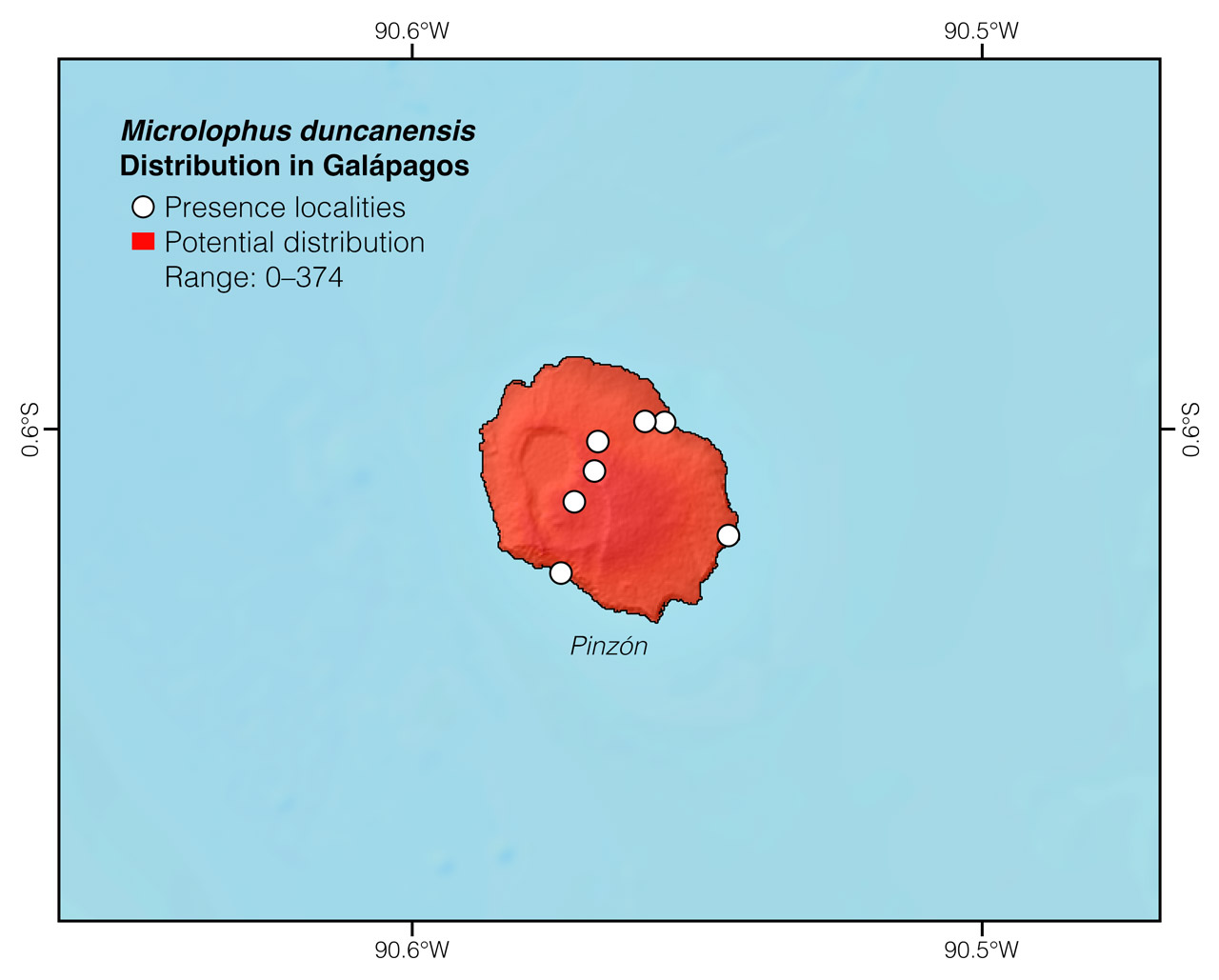Published October 10, 2019. Updated January 22, 2024. Open access. Peer-reviewed. | Purchase book ❯ |
Pinzón Lava-Lizard (Microlophus duncanensis)
Reptiles of Ecuador | Sauria | Tropiduridae | Microlophus duncanensis
English common names: Pinzón Lava-Lizard, Duncan Lava-Lizard.
Spanish common names: Lagartija de lava de Pinzón, lagartija de lava de Duncan.
Recognition: ♂♂ 26.8 cmMaximum distance from the snout to the tip of the tail. Snout–vent length=8.5 cm. ♀♀ 21.4 cmMaximum distance from the snout to the tip of the tail. Snout–vent length=7.6 cm..1,2 Microlophus duncanensis is easily distinguishable from other lizards occurring on Pinzón Island (that is, iguanas and leaf-toed geckos) by having keeled scales on the tail, a skin fold above the shoulder, a raised mid-dorsal crest, and a conspicuously enlarged interparietal scale.1 This is the only lava lizard occurring on Pinzón Island.1 Males and females of this species differ from each other in size, shape, and coloration. Unlike other lava lizards, the females of M. duncanensis are more brightly colored than the males.1,2 They have a striking reddish-orange coloration that covers most of their body (Fig. 1). Adult males have a dull reddish brown body and a black throat. They may be recognized by their larger size and raised middorsal crest.1,2

Figure 1: Individuals of Microlophus duncanensis from Playa Escondida, Pinzón Island, Galápagos, Ecuador. j=juvenile.
Natural history: Microlophus duncanensis is a diurnal, terrestrial to semi-arboreal lizard that inhabits the dry grasslands and seasonally dry forests of Pinzón Island.1 During the early morning or late afternoon, Pinzón Lava-Lizards bask and forage on soil, rocks, and shrubs up to 1.5 m above the ground.1 To avoid the hottest hours of the day, they move into the shade under bushes or lava blocks.3 During rains, the lizards seek refuge under rocks and shrubs, later drinking water that collects on the surface of leaves and rocks.1 There are recorded instances of predation on lizards of this species, including by native predators such as snakes (Pseudalsophis slevini) and hawks as well as (formerly) by introduced black rats.1,4 The diet in M. duncanensis consists of beetles, grubs, caterpillars, grasshoppers, and plant material such as fruits and seeds.3,5 Males defend their territory by performing pushup displays.6
Conservation: Near Threatened Not currently at risk of extinction, but requires some level of management to maintain healthy populations..7 Microlophus duncanensis is listed in this category because the species is restricted to an island of only 18 km2 and, thus, it is prone to be affected by random unpredictable events (like droughts and introduced species) within a short time period. Pinzón Lava-Lizards faced predation by rats for nearly 200 years,7 but the species now has (presumably) healthy population numbers in a rat-free island protected within the Galápagos National Park.
Distribution: Microlophus duncanensis is endemic to the 18 km2 area of Pinzón Island, Galápagos, Ecuador (Figs 2, 3).

Figure 2: Distribution of Microlophus duncanensis in Galápagos. See Appendix 1 for a complete list of the presence localities included in the map.

Figure 3: Distribution of Microlophus duncanensis in Pinzón Island. See Appendix 1 for a complete list of the presence localities included in the map.
Etymology: The generic name Microlophus comes from the Greek words mikros (=small) and lophos (=crest).1 The specific epithet duncanensis refers to Pinzón, previously known as Duncan Island.8 The island was originally named after Adam Duncan, a British admiral famous for defeating a Dutch fleet in 1797 during the French Revolutionary Wars, an action considered one of the most significant victories in naval history.9
See it in the wild: Pinzón Island is inaccessible to tourism. Researchers and members of the Galápagos National Park may visit the habitat of Microlophus duncanensis, but only in the context of a research expedition or a conservation agenda.
Authors: Alejandro ArteagaaAffiliation: Fundación Khamai, Reserva Arlequín, Ecoruta Paseo del Quinde km 56, Santa Rosa de Mindo, Pichincha 171202, Ecuador. and Juan M GuayasaminbAffiliation: Universidad San Francisco de Quito, Quito, Ecuador.
Academic reviewers: Edgar Benavides,cAffiliation: Yale University, New Have, USA. John Rowe,dAffiliation: Alma College, Alma, USA. and Cruz MárquezeAffiliation: University of Rome Tor Vergata, Rome, Italy.
Photographer: Jose VieirafAffiliation: Tropical Herping (TH), Quito, Ecuador.,gAffiliation: ExSitu, Quito, Ecuador.
How to cite? Arteaga A, Guayasamin JM (2024) Pinzón Lava-Lizard (Microlophus duncanensis). In: Arteaga A, Bustamante L, Vieira J (Eds) Reptiles of Ecuador: Life in the middle of the world. Available from: www.reptilesofecuador.com. DOI: 10.47051/NWZI6838
Literature cited:
- Arteaga A, Bustamante L, Vieira J, Tapia W, Guayasamin JM (2019) Reptiles of the Galápagos: life on the Enchanted Islands. Tropical Herping, Quito, 208 pp. DOI: 10.47051/AQJU7348
- Bowman RI (1966) Proceedings of the Symposia of the Galápagos International Scientific Project. University of California Press, Berkeley, 336 pp.
- Van Denburgh J, Slevin JR (1913) Expedition of the California Academy of Sciences to the Galápagos Islands, 1905-1906. IX. The Galapagoan lizards of the genus Tropidurus with notes on iguanas of the genera Conolophus and Amblyrhynchus. Proceedings of the California Academy of Sciences 2: 132–202.
- Ortiz-Catedral L, Christian E, Skirrow MJA, Rueda D, Sevilla C, Kumar K, Reyes EMR, Daltry JC (2019) Diet of six species of Galapagos terrestrial snakes (Pseudalsophis spp.) inferred from faecal samples. Herpetology Notes 12: 701–704.
- Hervías-Parejo S, Heleno R, Rumeu B, Guzmán B, Vargas P, Olesen JM, Traveset A, Vera C, Benavides E, Nogales M (2018) Small size does not restrain frugivory and seed dispersal across the evolutionary radiation of Galápagos lava lizards. Current Zoology 65: 353–361. DOI: 10.1093/cz/zoy066
- Clark DL, Macedonia JM, Rowe JW, Stuart MA, Kemp DJ, Ord TJ (2015) Evolution of displays in Galápagos lava lizards: comparative analyses of signallers and robot playbacks to receivers. Animal Behavior 109: 33–44. DOI: 10.1016/j.anbehav.2015.08.002
- Márquez C, Cisneros-Heredia DF (2016) Microlophus duncanensis. The IUCN Red List of threatened species. Available from: www.iucnredlist.org. DOI: 10.2305/IUCN.UK.2016-1.RLTS.T48444650A48444714.en
- Baur G (1890) Das Variieren der Eidechsen-Gattung Tropidurus auf den Galápagos Inseln und Bemerkungen über den Ursprung der Inselgruppe. Biologisches Centralblatt 10: 475–483.
- Laughton JK (1888) Duncan, Adam. In: Leslie S (Ed) Dictionary of national biography. Smith, Elder, and Co., London, 159–161.
Appendix 1: Locality data used to create the distribution map of Microlophus duncanensis in Ecuador (Fig. 2). Go to the section on symbols and abbreviations for a list of acronyms used.
| Country | Province | Locality | Source |
| Ecuador | Galápagos | Bahía de Pinzón | Hervías-Parejo 2018 |
| Ecuador | Galápagos | Brushy portion of Pinzón | Van Denburgh & Slevin 1913 |
| Ecuador | Galápagos | Meseta central de Pinzón | Arteaga et al. 2019 |
| Ecuador | Galápagos | Pinzón, eastern end | Arteaga et al. 2019 |
| Ecuador | Galápagos | Pinzón’s crater | Van Denburgh & Slevin 1913 |
| Ecuador | Galápagos | Playa Escondida | Benavides et al. 2009 |
| Ecuador | Galápagos | Trail to top | Van Denburgh & Slevin 1913 |